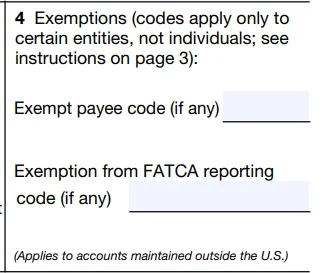
Form W-9 for LLC - How Can Limited Liability Companies Complete
a W-9?
Fill Out the W-9 for Your LLC for FREE!
- Complete and share your W-9 in 3 Simple Steps
- Fill out Once and share as many times as you want
- Securely store and access your completed W-9 anytime
New
Introducing TaxBandits W-9 Chrome Extension: Request, track, and manage W-9/W-8 forms in just a few clicks—no need to switch tabs or open the application. Download ExtensionW-9 for LLC (Limited Liability Companies) - An Overview
Form W-9 is essential for year-end 1099 filings for any business type, and LLC is no exception.
If a business hires your LLC and requests you to provide a W-9, you can quickly complete and share your W-9 Form using the TaxBandits Fillable W-9 solution.
On the other hand, if your LLC has hired and paid independent contractors, you can use TaxBandits W-9 Manager to quickly request W-9 Forms online, collect them, and manage them all in one place.
Purpose of Form W-9
Form W-9 is a commonly used IRS form that allows you to provide your LLC's Taxpayer Identification Number (TIN) to other businesses or individuals (payers who file 1099 Forms for you). Payers will use this information to report their payments on 1099 Forms.
The following information is required to complete Form W-9:
- Name and Address
- Business name (if applicable)
- Federal tax classification
- Taxpayer Identification Number (TIN) information
- Backup withholding requirement
- Exemption code for FATCA reporting
Failure to furnish a Form W-9 for your LLC can result in backup withholding, where up to 24% of your payments are withheld to ensure compliance with tax regulations.
Why Federal Tax Classification is important for completing form W-9 for your LLC?
When completing Form W-9 for your LLC, one of the most important sections is identifying your federal tax classification. This classification determines how your LLC is treated for federal tax purposes and influences how you report your income to the IRS. Getting this classification right is crucial to ensure accurate tax filings and avoid complications during audits.
Typically, LLCs are classified as:
Single Member LLCs:
If you are the sole owner of your LLC, your business is classified as a Single-Member LLC, also known as a disregarded Entity, for federal tax purposes.
Multi-Member LLCs:
If your LLC has more than two or more owners or shareholders, you can register your LLC to be treated as any of the following:
- Partnership: This business structure involves two or more members as owners or shareholders. Each partner pays individual taxes for their share of the profit.
- C Corporations: These are corporations with more than 100 shareholders, where the shareholders are liable for corporate income taxes and individual taxes on dividends they receive. This is known as double taxation.
- S-Corporation: These corporations with fewer than 100 shareholders have chosen to pass corporate income and losses to their shareholders for tax purposes. Thus, they don’t experience double taxation.
How to Fill Out a W-9 for an LLC
Form W-9 consists of 7 lines and 2 parts, followed by the date and signature fields. Here are the step-by-step instructions to
fill out a W-9 Form for your LLC:
-
Line 1 and 2- Name and Business Name
You must enter the applicable names in the first two fields based on your LLC's federal tax classification.
- If your LLC is a Disregarded entity, you must enter your name on Line 1 and then enter the name of your LLC on Line 2.
- For example, if your name is John Doe, and you operate under the DBA (Doing Business As) name ‘John Doe LLC’, you must enter the former on Line 1 and the latter on Line 2.
- If your LLC is treated as a Partnership or Corporation, you can enter your business name on Line 1 and leave Line 2 blank (or) enter any other trade or DBA name if you have one.
 TaxBandits provides a secure and fillable W-9 form at no cost. Fill out Form W-9 Now.
TaxBandits provides a secure and fillable W-9 form at no cost. Fill out Form W-9 Now. -
Line 3a - Federal Tax Classification
In this line, you can indicate how your LLC is classified for federal tax purposes.
- If your LLC is a Disregarded entity, you must check the box ‘Individual/sole proprietor or single-member LLC’.
-
If your LLC is treated as a Partnership or Corporation, you must check the box ‘Limited liability company’ and enter the corresponding code to indicate the classification.
- C = C Corporation,
- S = S Corporation,
- P = Partnership

-
Line 3b- Flow-through Entity
Check this box(3b) if you selected partnership (including an LLC treated as a partnership), trust, or estate on line 3a with foreign partners, owners, or beneficiaries and providing Form W-9 to a partnership, trust, or estate where you hold an ownership interest.

-
Line 4 - Exemptions
If you are exempt from backup withholding and/or FATCA reporting, enter the code(s) that may apply to you on line 4.

Exempt payee code
Individuals and sole proprietors are not exempt from backup withholding. Corporations are exempt from backup withholding for certain payments, such as interest and dividends, but not for payments made in settlement of payment card or third-party network transactions.
Additionally, corporations are subject to backup withholding for attorneys fees, gross proceeds paid to attorneys, and medical or health care service payments reportable on Form 1099-MISC.
Enter the appropriate code on line 4:
- Organizations exempt from tax under section 501(a), IRAs and custodial accounts classified under section 403(b)(7), and any accounts that classify under section 401(f)(2)
- United States or any of its agencies or instrumentalities
- A state, the District of Columbia, a U.S. commonwealth or territory, or any of their political subdivisions or instrumentalities
- A foreign government or any of its political subdivisions, agencies, or instrumentalities
- Corporations
- A dealer in securities or commodities is required to register in the United States, the District of Columbia, or a U.S. commonwealth or territory
- A futures commission merchant registered with the Commodity Futures Trading Commission
- Real estate investment trusts
- Entities that are registered throughout the tax year by the Investment Company Act of 1940
- Common trust funds operated by a bank under section 584(a)
- Financial institutions as defined under section 581
- A middleman known in the investment community as a nominee or custodian
- Trusts that are exempt from tax under section 664 or described in section 4947
Exemption from FATCA codes
The following codes identify payees that are exempt from reporting under FATCA.
- An organization exempt under section 501(a) or individual retirements plans under section 7701(a)(37)
- The United States or any of its agencies or instrumentalities
- A state, the District of Columbia, a U.S. commonwealth or territory, or any of their political subdivisions or instrumentalities
- A corporation the stock of which is regularly traded on one or more established securities markets, as described in Regulations section 1.1472-1(c)(1)(i)
- Corporations that are members of the same expanded affiliated group as a corporation described in Regulations section 1.1472-1(c)(1)(i)
- A dealer in securities, commodities, or derivative financial instruments (including notional principal contracts, futures, forwards, and options) that is registered as such under the laws of the United States or any state
- A real estate investment trust
- A regulated investment company as defined in section 851 or an entity registered at all times during the tax year under the Investment Company Act of 1940
- Common trust funds defined in section 584(a)
- A bank as defined in section 581
- A broker
- Trusts exempt from tax under section 664 or described in section 4947(a)(1)
- Tax-exempt trusts under a section 403(b) plan or section 457(g) plan
-
Line 5 & 6 - Address
Enter the complete address of your LLC, including Suite no./Apt no., street name, city, state, and ZIP code.
-
Line 7 - Account Number
This is not a mandatory field. If your LLC has any account numbers, you can list them here.

-
Part I - Taxpayer Identification Number (TIN)
This part requires you to provide your TIN, an Employer Identification Number (EIN), or a Social Security Number (SSN). The TIN you enter must match the IRS database.
- If your LLC is a single-member LLC that is a disregarded entity, you can enter your SSN.
- If your LLC is treated as a corporation or partnership, you can enter your EIN.

-
Part II - Certification
The last part of filling out your W-9 Form is the certification, which requires your LLC to acknowledge the following things.
- You are providing the correct taxpayer identification number
-
Your LLC is not subject to backup withholding because:
- It is exempt from backup withholding (or)
- The IRS has not notified you that your LLC is subject to backup withholding due to a failure to report all interest or dividends, (or)
- The IRS has informed you that your LLC is no longer subject to backup withholding
- You are a U.S. citizen
- The FATCA code(s) entered on this form (if any) indicating that you are exempt from FATCA reporting is correct.

-
Signature
You must sign the form after reviewing the IRS Form W-9 and checking that all the information is correct.
Fill Out a W-9 For Your LLC in Minutes with TaxBandits!
TaxBandits offers a fillable W-9 solution that allows your LLC to complete and share your Form W-9 electronically with your payers or requesters in no time.
Just follow the below steps to fill out the W-9 for your LLC:
- Step 1: Enter the required data on your Form W-9
- Step 2: Preview the data and e-sign the Form
- Step 3: Once e-signed, download or share it electronically with your payers.
TaxBandits also provides a comprehensive solution for requesting and automating Form W-9.
| Request and Manage W9/W8 BEN Online | Automate W-9 With TaxBandits API |
|---|---|
|
Our Form W-9 Manager lets you request, collect, and manage the W-9/W-8 forms of your contractors securely in one place. Learn More |
Integrating our developer-friendly API with your existing software or portal allows you to automate W-9 forms and streamline 1099 filing. Learn More |
